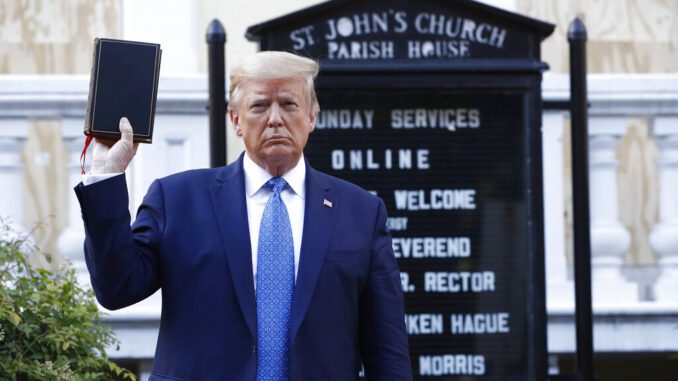
WASHINGTON, D.C. — An internal government investigation has determined that the decision to clear protesters against law enforcement from an area in front of the White House last summer was not influenced by then-President Donald Trump’s plan to walk to St. John’s Church.
The report released Wednesday by the Interior Department’s inspector general concludes that the protesters were cleared by U.S. Park Police last June 1 so that a contractor could get started installing new fencing.
The demonstrators were protesting the death of George Floyd, who died on May 24. A half-hour after the Washington protesters were forced from the area with pepper pellets and flash-bangs, Trump walked across Lafayette Park and delivered a short speech while holding a Bible in front of St. John’s Church.
Park Police officials had already planned to clear the area and “had begun implementing the operational plan several hours before they knew of a potential Presidential visit to the park,” Inspector General Mark Lee Greenblatt said in a statement accompanying the report.
The report documents Trump’s attorney general, William Barr, encouraging commanders shortly before the push to clear the protesters because of Trump, but being dismissed.
The report determined that the decision to clear the protesters was justified, but that law enforcement agencies on the scene failed to effectively communicate with each other and failed to communicate warnings to the protesters about the impending crackdown. Several different law enforcement agencies moved ahead of schedule and started engaging with protesters before the protesters had been sufficiently warned.
The confrontation and church photo-op capped several days of escalating tension and scattered violence. Nights of protests over Floyd’s death had resulted in widespread vandalism through the downtown area. Trump declared that Washington’s mayor, Muriel Bowser, was incapable of maintaining the peace and he called in his own security response.
The conclusions deny any political influence on decisions and cite fog-of-war confusion for any missteps.
The report tries to explain one of the main points of lingering contention: who used tear gas and when? It concludes that members of the city’s police department, who were stationed down the block, used CS gas near the corner of 17th and H Street.
In the aftermath of that day, the Park Police repeatedly insisted that its officers never used tear gas, while the police insisted that its officers were not involved in clearing protesters away from the church. Just last month, lawyers for the police department stated in federal court that its officers had used CS gas and other chemical irritants, claiming protesters had become violent and that one officer had his arm burned by a firework.
Much of the criticism of the clearing, and the accusations of political influence, stem from the decision to move in before the 7 p.m. curfew that Bowser had set. The push surprised protesters and was criticized as unnecessarily confrontational after two nights of clashes and property damage.
The report concludes that Park Police commanders viewed the curfew as irrelevant. It cites an incident commander as saying, “We were not enforcing the Mayor’s curfew. We’re a Federal entity. We don’t work directly for the Mayor.”
It continues that commanders on the scene “did not believe protesters would comply with the Mayor’s June 1 curfew order or that waiting would necessarily reduce unrest.”



